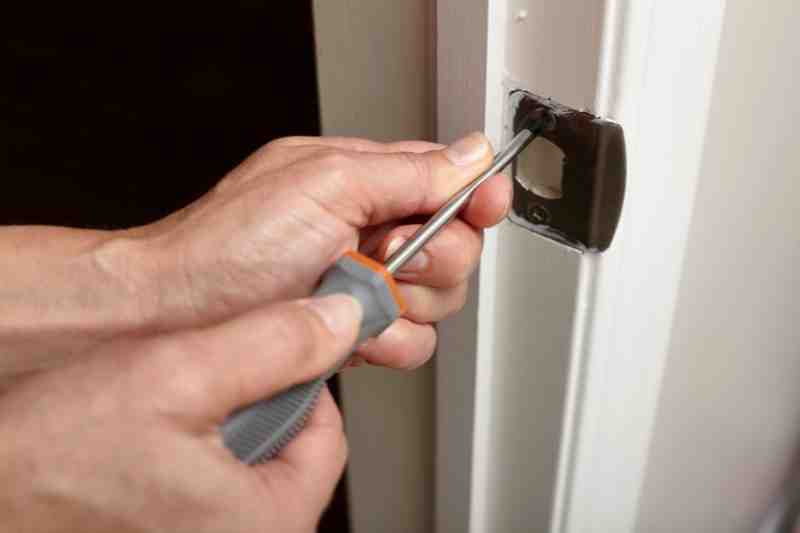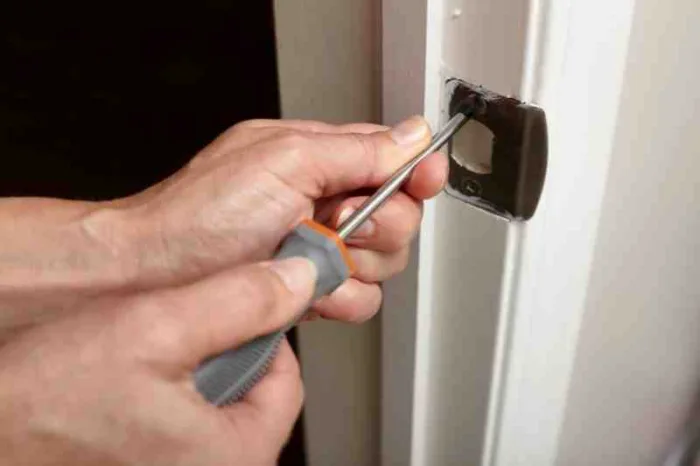Key takeaways
- The six best types of electric door strikes include the 1/2″ rim strikes, 4 series centerline strikes, all-in-one strikes, and 3/4″ rim strikes.
- A door strike is a metal plate on a doorframe that helps keep a door closed by securing a latch coming out of the door.
- You can upgrade your door strike using an electric one instead of an analog.
- The two different types of door strikes are fail-safe strikes and fail-secure strikes.
- The best type of door strike depends on the door’s location on your property and the amount of security you want to give to the area secured by that door.

When residents and visitors are using the doors on your property, they probably aren’t thinking about all of the different technologies that make access so convenient. But even the smallest pieces of door release hardware for apartment intercom systems with door releases, like door strikes, are instrumental in maintaining security and enabling remote access management.
In this post, we explain what a door strike is and the differences between various types of strikes. Then, we explain how you should choose different strikes for different areas of your property. Most importantly, you’ll discover the six best electric door strikes to pair alongside your apartment intercom.
This post covers:
- 6 best electric door strikes
- What is a door strike?
- What are the different types of door strikes?
- Which door strike is best?
- How can you upgrade a door strike?
6 best electric door strikes
- Locknetics 1/2″ rim strikes
- Dormakaba 4 series centerline strikes
- Best all-in-one strikes
- Trine 3/4″ rim strikes
- ADAM RITE electric strike
- h.e.s. 1500 series electric strike
1. Locknetics 1/2″ rim strikes
Price: $317
- Less energy with micro-motor technology.
- Can create more sizes.
- Small for compact installation.
2. Dormakaba 4 series centerline strikes
Price: $122
- Best for heavier applications.
- Vibration resistant.
- Can make room for different door frame sizes.
- Stainless steel.
- Perfect for commercial buildings.
3. Best all-in-one strikes
Price: $562
- Compatible with most locks.
- No specific faceplate is needed.
- Solenoid eliminates the risk of heating up.
4. Trine 3/4″ rim strikes
Price: $374
- Surface mounting doesn’t cut the frame.
- Compatible with rim exit devices.
- Stainless steel finish.
- Fail-safe/Fail-Secure
5. ADAM RITE electric strike
Price: $206.41
- Fail safe or fail secure
- Stainless steel with aluminum finish
- Compatible with wood or steel door frame
6. h.e.s. 1500 series electric strike
Price: $170+
- Multiple finishes
- Dual lock monitors
- Tamper-resistant
- Dual voltage
What is a door strike?
A door strike is a metal plate on a doorframe that helps keep a door closed by securing a latch coming out of the door. Chances are, you’ve used one today — even if you haven’t realized it.
Doorplate strikes play an important role in securing entryways. When a door is closed, you can push on it as hard as you can — but if you don’t turn the doorknob, the door won’t open. That’s thanks to the door strike, which keeps the door closed by trapping a latch that comes out of the locking mechanism in the door.
After you turn the knob, the electric latch sticking into the strike retreats back into the door. And with nothing in the door security plate, you can easily open the door.
What are the different types of door strikes?
The two different types are fail-safe strikes and fail-secure strikes.
In a fail-safe system, the strike always has power flowing into it. When a user enters a credential, the system responds by briefly cutting power to the strike plate lock. That’s the signal that the strike takes to unlock the door.
In contrast, a fail-secure lock uses electricity the other way around. A fail-safe strike does not have current flowing to it at all times. Instead, when a user scans their credential, the access reader responds by sending a short burst of electricity to the strike, signaling it to unlock.
Fail-safe vs. fail-secure
To illustrate the difference, we can explore what happens to both types of locks in the event of a power failure.
If there’s no power, a fail-safe lock will automatically unlock and allow access. In other words, this kind of lock will help keep people safe if they ever have to evacuate the building — even if the power is out.
In contrast, a fail-secure lock will stay locked when there’s no power flowing to it. Fail-secure locks keep areas of your property secure in the event of a power failure.
Learn about the differences between electric strikes and magnetic locks:
Which door strike is best?
The type of door electric strike you should pick depends on the door’s location on your property and the amount of security you want to give to the area secured by that door. You also need to keep safety concerns and egress in mind.
You should use fail-safe electric strike locks in areas that people will pass through to leave your property if there’s an emergency, like stairwells or garages. If there’s a power failure, you wouldn’t want to trap people inside — and your local fire safety code likely requires it, too.
However, in other areas of your property, you’ll need to balance the need for a safe exit with the security of any equipment or items that you’re storing. You might want to use fail-secure locks to protect highly sensitive areas of your property, like document storage or server rooms.
How can you upgrade a door strike?
You can upgrade your door strike by using an electric strike instead of an analog strike. Electric door strikes have an additional part called a keeper that swings outwards to release an electronic latch. With this, you can install an access control device that reads credentials, like PIN codes or fobs.
While door strikes do an important job, they’re nothing fancy — essentially, they’re just metal plates. But, thanks to advances in technology, even strikes have their share of upgrades that help simplify access management on your property.
You can trigger an electric strike with access control hardware like:
- Keypads
- Intercoms
- Key fob readers
- Motion sensors
Further, you can opt for a more aesthetically pleasing electric strike with a no-cut electric strike. This is a type of electric strike that contains the strike locking mechanism inside the doorframe.

Learn more about ButterflyMX
Fill in the form below, and we'll email you right back.
Have questions?
Fill in the form below, and we'll email you right back.






